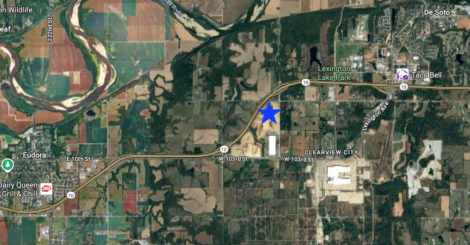
A $1.2B project to widen K-10 to six lanes near De Soto wins key federal environmental approvals
Widening likely wouldn't begin before 2028

photo by: Chad Lawhorn/Journal-World
Traffic travels westward on Kansas Highway 10 near the Douglas-Johnson County line on April 19, 2024.
Anybody who remembers the approximately 20-year effort to win approval for the South Lawrence Trafficway project, likely recalls there’s a formula to the process — first the bureaucrats, then the bulldozers.
That formula still holds, which means this was a big week for an approximately $1.2 billion project that eventually will widen Kansas Highway 10 in Johnson County to six lanes. The project won a key bureaucratic blessing.
The Federal Highway Administration issued a finding that the road widening project — which also will include rebuilding several interchanges — will have “no significant impact” on the environment.
Negative environmental findings have been known to delay or halt many a road project, and indeed it was this very environmental process that put the SLT project on hold for the better part of two decades.
At this point, it is a good bet Lawrence residents commuting to Johnson County will see major construction on K-10 far sooner than that. With the ruling by the Federal Highway Administration, the Kansas Department of Transportation announced it now has the necessary federal approvals to begin the project.
Don’t expect construction work to begin immediately, however. The project hasn’t yet secured all of its construction funding, but the Kansas Legislature — full of Johnson County lawmakers — likely will start obliging on that front soon. Plus, there’s the matter of the $4 billion Panasonic electric vehicle battery plant that is located just off of K-10 at De Soto. The traffic that project is expected generate when fully open — a celebration to officially open the first phase of the plant is next month — likely will add to the pressure to find funding for K-10.
Once the construction project begins, it likely will impact Lawrence commuters for years. The project stretches 16.5 miles, and in addition to the road widening, includes the construction or reconfiguring of 10 interchanges.
None of the project, however, stretches into Douglas County. All the work will stop before the Douglas-Johnson county line. The closest the project will get to Douglas County is a work to reconfigure the K-10 and Evening Star Road interchange, which is just less than two miles east of the Eudora city limits.

photo by: Google Maps/Journal-World
The red stars show the locations of Eudora’s two K-10 interchanges. The blue start shows the location of the Panasonic battery plant. The orange star shows the location of the Evening Star Road interchange, where millions of square feet of warehouse space is being constructed. The gray star roughly shows where the six-lane portion of K-10 Highway would begin for motorists heading eastward. The purple line shows a portion of W. 103rd street that is being widened and improved currently. Eudora officials had hoped the road would be improved to city’s eastern interchange.
As we reported in April 2024, some Eudora leaders were upset that none of the road improvements would stretch to that community of about 6,000 people. In particular, there were hopes that Eudora’s eastern interchange on K-10 would get some improvements where it connects with Old K-10 Highway, also known as N 1400 Road. That road — it is called W 103rd Street when it crosses into Johnson County — runs right in front of the Panasonic plant, which is expected to employ 4,000 people at capacity.
Eudora Mayor Tim Reazin told the Journal-World last year that it is reasonable to expect the Douglas County portion of the road is going to see significantly higher traffic volumes, and thus ought to get included in some of the improvements.
Road planners, though, weren’t of that view last year, and their thinking never changed. KDOT officials last year told me their data showed far more Panasonic employees would come from east of De Soto than from west of De Soto.
“It is a pretty definite split,” Steven Cross, KDOT’s project manager for the K-10 expansion, said in April 2024 of the east versus west job numbers.
The design of the expansion project reflects that view. The widening of K-10 to six lanes would begin at the Lexington interchange in De Soto, and would stretch all the way to the I-435 gateway intersection near Lenexa.
Plans call for the road to be widened by adding a new inside lane in each direction. That means the grass median eventually will be a feature of the past. Instead, the road likely will be designed to have a concrete barrier separating the east and west traffic.
KDOT officials haven’t given any firm dates for when construction work would begin on the project. Last year, KDOT officials had suggested road widening work likely wouldn’t begin before 2028. They also were basing that on the idea that the project would receive federal approvals by the end of 2024. The federal approvals came about six months behind that schedule.

photo by: Chad Lawhorn/Journal-World
Motorists on Kansas Highway 10 pass a sign advertising future commercial development near the Lexington Avenue interchange in De Soto on April 19, 2024.
When widening work does begin, it likely will begin on the east end of the highway, with the work near De Soto happening later. In addition expanding the roadway by two lanes, here’s a look at other projects included in the plan:
• Reconfigure all or parts of the following interchanges on K-10: K-7, I-435, Evening Star Road, Lexington Avenue, Woodland Road, and Renner Boulevard.
• Build a new interchange at K-10 and Lone Elm Road.
• Reconfigure portions of the I-435 and I-35 interchange
• Reconfigure the K-7 and Prairie Star Parkway interchange
• Reconfigure the Lackman Road and I-435 interchange
• Reconstruct nearly every bridge along the route
• Improve several streets that cross the K-10 corridor
As a side note, the environmental impact statement for the project was one of the first to get approved under the new regulations from the Trump administration, which removed considerations related to environmental justice and other topics. The approved plan lists the four sections of the study that originally were scheduled to be part of the report, but were removed in their entirety due to the new Trump administration rulings. Those included a section on environmental justice impacts and two sections related to minority and low income populations.







